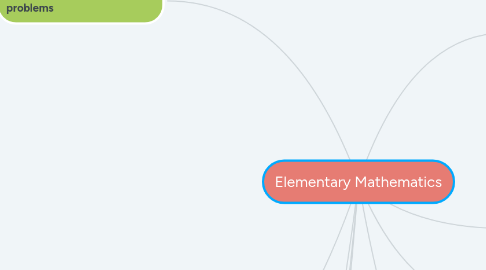
1. Solving Multiplication/Division problems
1.1. multiplication properties
1.1.1. Identity-When a number is multiplied by 1, the number stays the same.
1.1.2. Zero- when a number is multiplied by 0, the product is 0.
1.1.3. Associative- the way numbers are grouped doesn't matter.
1.1.4. Distributive- Breaking numbers into smaller parts/equations will result in the same product.
1.2. Multiplication Algorithms
1.2.1. Standard- Should be the last step students use to solve. no explanation on place values
1.2.2. Expanded Notation- Factors are expanded and then multiplied
1.2.3. Place Value- Factors are seperated into their place values, multiplied then added together.
1.2.4. Lattice
1.2.4.1. Lattice Multiplication Intro: 3 digits times 2 digits
2. Solving Addition/Subtraction problems
2.1. Addition Properties
2.1.1. Identity property- Any number added by zero will stay the same
2.1.1.1. a+0=a
2.1.1.2. 5+0=0
2.1.2. Communitive property- Order in which numbers are added doesn't matter
2.1.2.1. a+b=b+a
2.1.2.2. 4+3=3+4
2.1.3. Associative property- the way numbers are grouped doesn't matter
2.1.3.1. (a+b)+c= a+(b+c)
2.1.4. PROPERTIES OF ADDITION
2.2. Addition Algorithms
2.2.1. Standard American Algorithm- Last method students should use. No reference to place value
2.2.2. Partial Sums- No explicit reference to place value. Start right to left
2.2.3. Partial sums with emphasis on place value- There's more of an emphasis on place value. Problems are solved right to left.
2.2.4. Place value explicit- Problems are solved left to right instead of right to left.
2.2.5. expanded notation- Place value is very explicit. addents are expanded into corresponding place values.
2.2.6. lattice method- Place value is emphasized. A box is created to solve the problem.
2.3. Subtraction Algorithms
2.3.1. American Standard- No emphasis on place value. Should be the last method used.
2.3.2. European-Mexican- No emphasis on place value. It is solved right to left.
2.3.3. Reverse-Indian-There is no emphasis on place value. Solved left to right.
2.3.4. Left-to-right- Solved left to right. There's more of an emphasis on place value.
2.3.5. Expanded Notation- There's an emphasis in place value. The minuend and subtrahend are expanded and then subtracted.
2.3.6. Integer subtraction- Numbers are subtracted regardless if the difference is negative. then add all integers together to find the difference.
3. Divisibility
3.1. Important Terminology
3.1.1. -10 is divisible by 5 or 5 divides 10
3.1.2. -5 is a divisor of 10
3.1.3. -5 is a factor of 10
3.1.4. -10 is a multiple of 5
3.2. Divisibility Rules
4. Fractions
4.1. Models
4.2. Adding and subtracting
4.3. Multiplication
4.4. Drawing pictures
5. Percentages
5.1. Solving
5.2. Math Antics - Convert any Fraction to a Decimal
6. Problem Solving
6.1. Four Step Problem Solving
6.1.1. 1. Understand the problem
6.1.1.1. Ask yourself a couple of questions: Can you restate the problem in your own words? What are you asked to find out and how?
6.1.2. 2. Devise a plan
6.1.2.1. What strategies will you be using? Examples: trial and error, working backwards, creating a diagram
6.1.3. 3. Carry out the plan
6.1.3.1. -Be patient, most problems are not solved quickly or on first attempt. Be persistent and don't be discouraged.
6.1.4. 4. Look back and Reflect
6.1.4.1. Does your answer make sense? Were all questions answered? What did you learn?
6.2. Youtube Video
6.2.1. Problem Solving using Polya's Four Steps
7. Number System Bases
7.1. Base-10
7.1.1. -One unit
7.1.2. Ten units make a ten
7.1.3. ten tens make a hundred
7.1.4. ten hundreds make a thousand
7.1.5. a tenth of a unit is a tenth
7.1.6. a tenth of a tenth is a hundredth
7.1.7. a tenth of a hundredth is a thousandth
7.1.8. What does base 10 mean?
7.2. Other number systems
7.2.1. the roman system
7.2.2. binary system (base 2)- used in computing
7.2.3. octal system (base-8)
7.2.4. hexadecimal system (base-16)
7.2.5. base-5 and base-12 (indigenous people might use this)
7.3. Digits used
7.3.1. base 10- 0,1,2,3,4,5,6,7,8,9
7.3.2. base 2- 0,1
7.3.3. base 3- 0,1,2
7.3.4. base 4- 0,1,3
7.3.5. base 5- 0,1,2,3,4
8. GCF and LCM
8.1. GCF- Greatest Common Factor
8.2. LCM- Least Common Multiple
8.3. List method and Prime Numbers
8.4. Prime factorization method
9. Decimals
9.1. Powers of ten
9.2. Addition/multiplication/division
9.3. Youtube video
9.3.1. Adding Decimals | 5th Grade Math
